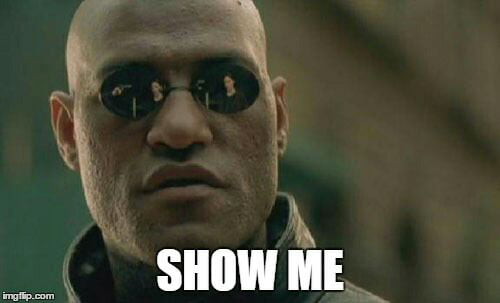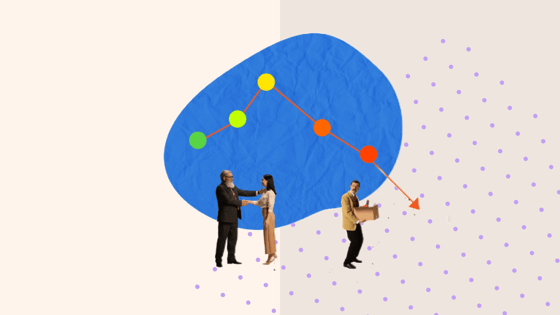Said no reputable business owner, ever.
Why go through the process of drawing your ideal customers in only to let them fall through the cracks into the abyss of un-nurtured leads?
It’s a waste of time, effort, and money if you don’t do everything possible to turn those leads into raving fans. Into customers who stay, advocate, and buy more of your products while shouting, “Take my money!”
Enter lifecycle marketing.
Why? Let’s find out. This guide highlights B2B lifecycle marketing, the strategies you can use to make the most of it, and tips to help you execute those strategies. It’s time to turn your leads into brand advocates.
B2B buyers are often responsible for making purchase decisions on their companies’ behalf, so multiple stakeholders and departments are often involved. There’s also a higher risk level with B2B purchases, both financially and operationally.
Related Read: The 5 Fundamentals of Inbound Marketing: A Simple Strategy for Better Growth
Buyers will evaluate multiple providers and take time to decide. Therefore, B2B marketers and sales reps must understand the buyer’s unique needs, provide them with relevant resources, and address any objections they may have. This process will help eliminate friction in your SaaS buyer journey.
That’s why B2B lifecycle marketing recognizes that building trust and ongoing customer relationships are essential. So how do you keep B2B buyers engaged through multiple channels and stages? First, let’s break down the B2B lifecycle.
Understanding the B2B Lifecycle
Think of the B2B lifecycle as a framework. But before I dive into each stage, consider the B2B journey.
It’s not always linear. It can vary based on customer needs and preferences. For example, customers may skip the awareness and consideration stages if they already know what they want to purchase or go back and forth between stages before deciding.
1. Awareness
Potential customers become aware of your business. Perhaps they’re having an issue and are looking for possible answers to their problems. You should be able to build brand awareness and establish trust with potential customers with messaging that resonates.
2. Consideration
Potential customers know who you are. They can see that your solution could solve their problems, but they’re also looking at other options. Here, you’ll focus on providing resources like webinars, whitepapers, and case studies to help potential customers make informed decisions.
3. Purchase
In the purchase stage, potential customers become customers. Their buying experience, ease of implementing your product, and the onboarding process will factor into an overall customer experience. At this stage, do everything you can to provide a positive experience.
4. Adoption
Here, your customer starts using your product or service. Now is the perfect time to show how good your customer support is. An onboarding series might work well, but being available and quick to help is essential.
5. Retention
In the retention stage, you’re starting to build long-term loyalty. Introducing a product update? Tell your customer about it and help them get the most out of it. Introducing a loyalty program is never a bad idea, and you can reward repeat customers with discounts, exclusive content, and other incentives.
6. Advocacy
Happy customers are your best marketers. You want loyal customers to become brand advocates. You can leverage advocacy to drive referrals and word-of-mouth marketing. Ask for feedback, reviews, and video testimonials to help increase your brand awareness.
Notice I ended with “increase your brand awareness,” which brings us full circle to the first lifecycle stage.
Benefits of B2B Lifecycle Marketing
If you want to build long-term, profitable customer relationships, marketing can’t stop with generating leads. It has to be a long-term investment. The benefits are plenty.
- Increased customer retention: By engaging with customers throughout the entire customer journey, you can build stronger relationships and increase the chances of retaining customers. According to a study by Bain & Company, a 5% increase in customer retention can lead to a 25-95% increase in profits.
- Higher revenue: By delivering targeted and personalized campaigns at each stage of the customer journey, you increase the chances of making a sale and generating more revenue. 80% of your future profits will come from just 20% of your existing customers. Create loyal customers!
- Stronger brand reputation: Build a strong brand reputation and increase the chances of customers becoming advocates. According to Nielsen, 92% of consumers trust recommendations from friends and family over advertising.
- Better customer experience: By delivering the right message, at the right time, through the ideal channels, you create a better customer experience and will see increased customer satisfaction and loyalty. According to a study by Salesforce, 73% of customers expect companies to understand their needs and expectations.
But the most significant benefit from a marketing point of view is a positive return on investment (ROI). With targeting and segmentation, you’ll reduce wasted spend on marketing campaigns that don’t convert.
You’ll lower customer acquisition costs and reduce time and resources – and by tracking and measuring key performance indicators (KPIs) at every stage of the customer lifecycle, you can refine and optimize marketing campaigns.
Now that you understand “the what,” let’s look at the how.

Image source
Strategies for B2B Lifecycle Marketing
Each lifecycle stage requires a different approach.
Awareness
Let’s say a prospect struggles with staying on top of HR management, and your company provides tools to streamline HR.
You can create a series of blog posts to make potential customers aware of your product or service. The posts explain the best way to streamline HR processes to provide a lead magnet that gives the reader a quick win.
Think of it like a checklist of things they can do to take something off their plate.
Now, thanks to the posts, your potential customer is aware of you, can see that you know how to solve their problem, and might be open to building a relationship.
You could also:
- Run targeted ads on social media platforms.
- Run targeted ads on search engines to reach potential customers searching for keywords related to your industry or products.
Related Read: How To Do B2B Social Media Marketing: 5 Simple Strategies
Pro tip: LinkedIn is where many B2B folks hang out. You can target decision-makers in specific industries and share your expertise with a captive audience.
Consideration
Sticking with the HR scenario, let’s say your potential customer can see the benefits of your software and wants to show other stakeholders. It’s the perfect time to give them the resources they need!
Then–assuming you got their email address when they downloaded your lead magnet–start engaging.
Provide detailed product or service information, including features, benefits, and pricing. Share customer reviews and testimonials to build trust and credibility, or continue the conversation with helpful advice and success stories.
Every time a potential customer says yes–whether by taking action or carrying on the conversation–they’re a step closer to talking to sales.
Pro tip: Find and fix friction points. From years of working with B2B SaaS brands, the most common friction points are brochure websites that don’t resonate with customers, weak lead magnets, and lack of differentiation. Sound familiar? We can help.
Purchase
The company struggling with its HR processes is a high-value account. So how can you ensure they’ll decide to work with you? The best thing you can do is get the stakeholder you need on a call.
Sell the call, not your product or service.
Use personalization here. Remember, you’re speaking to a human, not the business. Make the call a no-brainer. Figure out how much value you can pack into a call that makes getting them on the phone easy. You’ve got to make this stage frictionless.
- Offer a live demo or a free trial
- Be transparent with pricing
- Use a dedicated sales team and get your marketing department to provide the resources they need to make a sale
- Use case studies and testimonials from other businesses in the same industry
- Automate the creation, signing, and tracking of contracts using contract management software
Pro tip: Track the right metrics here, including customer acquisition cost (CAC). It’s the dollar amount it costs to acquire new customers. Lower your CAC by targeting best-fit leads instead of poor leads.
Adoption
The hard work is over, right? You have your customer; time to go back to driving awareness. Slow your roll there, partner.
Once you make a sale and your customer starts using your HR product to streamline their processes, you’ve got to create a stellar customer experience. Is your product intuitive and easy to use? What’s your onboarding process like?
Personalized onboarding will go a long way. Your customer can get up to speed quickly and start seeing the value immediately. Other resources, like product tours, welcome emails, and pieces of training are helpful here.
Pro tip: Gather customer feedback about their onboarding and adoption experience to help identify areas for improvement and provide insights into customer needs and preferences.
Retention
Adoption feeds retention. If you say you’re available for support, be available. The easiest way to lose customers is to make promises and not deliver the service you say you will.
Think of your customer in HR. Any issues or downtime could harm their operations if they’re using your product for their HR needs. Go above and beyond to help when they have a problem. Be transparent and helpful.
It costs up to 5 times more to acquire a customer than to keep current customers, so it’s worth investing in this stage.
- Create customer loyalty programs, including early access to new features, discounts on long-term contracts, and other perks only available to loyal customers.
- Engage your customers with personalized content tailored to their interests and needs. Email campaigns, customized recommendations, and relevant blog posts can all help.
Pro tip: Figure out why your customers stick with you. Ask them. And use their response to communicate with prospective customers. Sharing why they should buy from you is less important than proving why they should stay with you.
Advocacy
The key at this stage is to leverage customer advocacy to drive referrals and new business. Your reputation precedes you, and customer advocacy is the ultimate marketing tool.
User-generated content is a strong play here.
Encourage your users to share their experiences. For example, if your product solves an issue many HR departments struggle with, ask your customers to share a quick video using your software.
Related Read: The Ultimate Growth Marketing Guide: Steps, Tips, Tools & Examples
You could also offer a referral program, including incentives and rewards. But you’ve got to implement the program. Of course, sharing your business won’t be top of mind for your customers, but if you prompt them and they’re happy with your service, they’ll oblige.
Pro tip:
- If you get negative reviews, don’t shy away from them.
- Respond promptly and professionally.
- Build trust and improve your reputation by demonstrating that you value customer opinions and are committed to addressing their concerns.
VIDEO TRAINING
Get The Growth Marketing Playbook.
Learn to plan, budget, and accelerate growth with our exclusive video series. You’ll discover:
- The 5 phases of profitable growth
- 12 core assets all high-growth companies have
- Difference between mediocre marketing and meteoric campaigns
Thanks for submitting the form!
Tips to Optimize B2B Lifecycle Marketing
Here are some tips from experience.
Common Mistakes to Avoid
- Not segmenting your lists
When you don’t segment your audience, you risk wasting your time and resources and alienating your customers. Are lower conversion rates due to your marketing materials or because you targeted the wrong audience?
This is where a data-driven approach shines. Through segmentation, you deliver relevant solutions and improve the customer experience.
The market sees you. But whether it believes your messaging or not is another matter. A lack of consistency in your messaging, branding, and delivery channels often leads to confusion. Instead of trying your luck with email, social media, and other avenues, stick with one.
Find out where your audience hangs out and meet them there. People want a consistent experience with your brand.
- Over-relying on Automation
Marketing automation is an excellent way to save time on repetitive tasks. For example, ensure onboarding emails reach customers at the right time, lead magnet delivery is swift, and take care of various aspects of communication.
But – you don’t want your campaigns to feel generic and impersonal—balance automation with a human touch. For example, a chatbot might give generic answers to a customer service issue, but a human taking care of problems immediately helps create more meaningful connections.
If you don’t know your numbers, you don’t know your business.
When you don’t track marketing campaigns, you miss opportunities to find and fix friction and keep making the same mistakes. Instead, regularly monitor and analyze the performance of your campaigns to identify what works and what doesn’t.
Tips for Execution
Collaboration is essential in B2B lifecycle marketing. With long sales cycles, multiple touchpoints, and a non-linear buyer journey, you must ensure collaboration between the marketing, design, and sales departments.
Align on goals and KPIs and work towards common goals. For example, instead of marketing producing resources from their own ideas, they can talk to sales and see the resources sales reps need to help customers decide.
Data is at your fingertips. Whether from web analytics, your CRM, or customer feedback, improving the customer experience throughout the buyer journey has never been easier.
You can gain insights into customer behavior, preferences, and needs and use this information to tailor your marketing efforts, improve customer targeting, and optimize your campaigns.
B2B lifecycle marketing requires a commitment to pivot when things aren’t working. Is your lead magnet not converting? Why? It could be the wrong thing, CTA, delivery, or any number of things.
Always start with a minimum viable product (MVP) and iterate from there. Regularly review and assess your marketing efforts, incorporating feedback and insights from customers, prospects, and internal stakeholders.
B2B Lifecycle Marketing: Beyond the Guide
Though the B2B lifecycle differs for every business, use this guide as a starting point. These common principles remain and can help, no matter your services or niche:
- Personalize the buyer journey for your customers
- Nail your messaging through customer feedback and the problems you solve
- Be data-driven, and don’t be afraid to experiment
- Embrace a cross-functional team
Of course, you don’t have to do all of this alone. At Lean Labs, B2B SaaS marketing is our bread and butter. Through years of experience and driving growth for our clients, we understand your unique challenges and can help you win.
It all starts with strategy. Without one, you’re just guessing and hoping for the best. Do you want to see how we create a growth strategy that drives massive success?
Unlock the Growth Playbook today.








